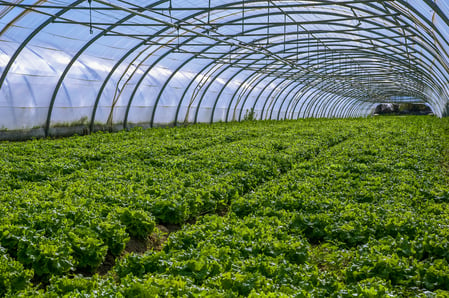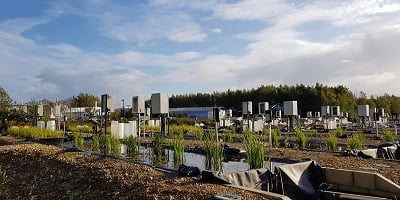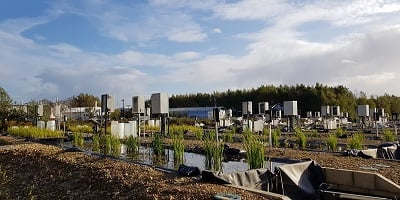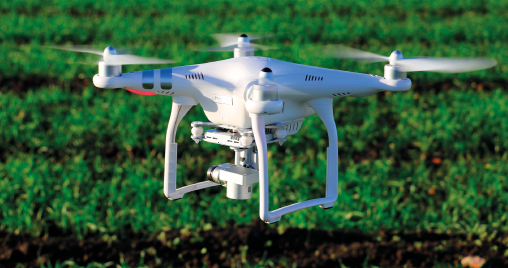Soil is the foundation of our food system, a complex ecosystem that sustains crops and plants that nourish us. It serves as a habitat for millions of microorganisms, invertebrates, and other forms of biodiversity that play crucial roles in maintaining soil health. The quality of soil impacts everything from crop resilience and soil structure (water retention, gas transport, and pore structure complexity) to the long-term sustainability of farming practices.
When soil health deteriorates, crops struggle, and food production becomes increasingly difficult to maintain. This often leads to a cycle of rising production costs and diminishing yields, with increased dependency on expensive fertilisers, pesticides, and irrigation. Investing in soil health can have significant financial benefits, helping businesses and farmers improve productivity.
What is soil health?
 Soil health refers to the continued capacity of soil to function as a living ecosystem that supports plant growth, maintains biodiversity, and provides essential ecosystem services. It encompasses the interactions of the physical and chemical properties with the biological processes that occur within the soil matrix. Healthy soil is a dynamic environment where these properties work together to support plant life, promote nutrient cycling, and maintain soil structure, making it a critical component of sustainable land management.
Soil health refers to the continued capacity of soil to function as a living ecosystem that supports plant growth, maintains biodiversity, and provides essential ecosystem services. It encompasses the interactions of the physical and chemical properties with the biological processes that occur within the soil matrix. Healthy soil is a dynamic environment where these properties work together to support plant life, promote nutrient cycling, and maintain soil structure, making it a critical component of sustainable land management.
Indicators of good soil health
Soil health indicators are a composite set of quantifiable biological, chemical, and physical-chemical variables relating to soil processes that determine the ecosystem functions and services the soil provides. These indicators are sensitive to global change drivers and are used to elucidate soil health status as impacted by (agronomic) management practices and climate change. They include the following:

Why is soil health under threat?
A 2019 report from the Environment Agency revealed that in England and Wales:
- Nearly 4 million hectares of soil face a risk of compaction.
- Over 2 million hectares are vulnerable to erosion.
- Intensive farming practices have led to a loss of approximately 40–60% of organic carbon in arable soils.
- The annual cost of soil degradation was estimated at £1.2 billion.[1]
These figures highlight the increasing challenges facing soil health. Modern agricultural practices, combined with environmental pressures, have placed significant strain on this essential resource.
Without sound and sustainable soil management intervention, declining soil health will continue to threaten food production, increase costs for retailers and farmers, and contribute to broader ecological damage.
Some of the major threats to soil health include:
-
Overuse of chemical inputs
The widespread reliance on synthetic fertilisers, pesticides, and herbicides has disrupted natural soil ecosystems. While these inputs can boost short-term yields, excessive use depletes microbial diversity, weakens soil structure, disrupts the soil's ecological balance, and reduces the soil’s ability to retain nutrients. -
Intensive farming practices
Monocropping, deep tillage, and heavy machinery use have become standard in large-scale agriculture, but they come at a cost. Continuous monocropping depletes specific nutrients, leading to soil exhaustion, while deep tillage breaks down soil structure and aggregates. This subsequently exposes the soil carbon protected within the macroaggregates to accelerated decomposition by opportunistic soil microbes. Thus, carbon loss is accelerated. Tillage also predisposes the soil carbon to atmospheric oxygen. Thus, the exposed carbon is oxidised and lost to the atmosphere in the form of CO2. Compaction from heavy machinery further reduces water infiltration and root penetration, making crops more vulnerable to drought and reducing overall productivity. -
Soil erosion
Factors such as deforestation, excessive tillage, and poor land cover management leave soil exposed to wind and water erosion. When topsoil (the most nutrient-rich layer) is stripped away, crop yields suffer, and land restoration becomes an expensive, long-term challenge.
-
Climate change
Unpredictable weather patterns, prolonged droughts, and extreme rainfall events further stress soil conditions, exacerbating erosion and nutrient loss. Heavy rainfall can lead to waterlogging and increased flood risk, which degrade soil structure and wash away vital nutrients.
Proactive measures to improve soil health
The quality and functionality of soil are directly influenced by how it’s managed, and small changes can yield substantial improvements in soil resilience, productivity, and long-term sustainability. Through deliberate practices, soil health can be enhanced, which in turn can significantly improve farm profitability and long-term return on investment (ROI).
Here are some effective strategies for building healthier, more resilient soils:
- Sustainable agricultural practices such as cover cropping, crop rotation, reduced tillage, and organic matter enrichment help maintain soil structure, reduce dependency on synthetic inputs and improve fertility. These methods support the soil microbiota enhancing long-term soil stability and productivity.
- Landscape water management plays a crucial role in preventing erosion and improving soil moisture retention. Techniques like rainwater harvesting, drought-resistant landscaping, and strategic drainage planning ensure efficient water use while minimising runoff. Incorporating natural land features, such as slopes and elevation changes, helps regulate water flow and supports soil regeneration.
- Vegetation incorporation strengthens soil resilience by introducing diverse plant species that can stabilise soil, reduce water run-off, and act as filters to remove pollutants, improving soil, water and air quality. Selecting deep-rooted plants enhances soil structure, while ground covers, shrubs, and trees provide shade, windbreaks, and wildlife habitats. Thoughtful plant placement ensures both functional and ecological benefits.
- Carbon sequestration is another critical strategy for soil health, capturing atmospheric carbon and storing it in soil through practices like agroforestry, biochar application, and regenerative farming. These methods not only improve soil organic matter but also help mitigate climate change by reducing greenhouse gas emissions.
While traditional methods like cover cropping and reduced tillage remain essential, an increasing understanding of soil's biological health is revolutionising how we approach soil management. Focusing on soil microbiology, the network of microorganisms that supports plant growth and nutrient cycling can unlock new potential for enhancing soil fertility, boosting productivity, and ultimately improving ROI:
-
Monitoring soil microbial health
Monitoring soil biology enables the assessment of the effectiveness of soil management practices and making data-driven decisions. Advanced tools, such as DNA profiling, microbial DNA sequencing and phospholipid fatty acid (PLFA) profiling, provide insights into:
- Microbial diversity and abundance: Identifying the types and quantities of microbes can help assess soil health and predict nutrient cycling efficiency.
- Microbial activity: Analysing microbial function, such as nitrogen fixation or phosphorous solubilisation, and metabolic quotients, such as microbial efficiency and specific maintenance respiration, gives information on soil nutrient availability and microbial resilience.
-
Using Nematodes as Bioindicators
Nematodes, microscopic organisms found in soil, are powerful bioindicators of soil health. These organisms are highly sensitive to changes in soil conditions, making them useful tools for monitoring soil biology. Nematodes help by:
- Indicating soil balance: The presence and abundance of different nematode species can reveal the overall soil health, including nutrient availability, disturbance levels, and the balance between beneficial and harmful nematodes.
- Assessing soil toxicity: Nematode populations decline when soil is contaminated or heavily fertilised, providing early signs of nutrient imbalance or toxic conditions.
- Monitoring soil food webs: Nematodes play a role in the soil food web by feeding on bacteria, fungi, and other soil organisms, helping regulate microbial populations and nutrient cycling.
Learn how using Nematodes as Bioindicators can provide valuable insights into soil health and help you adapt management strategies accordingly.
The financial rewards of healthy soil
Investing in soil health not only contributes to environmental sustainability but also offers considerable financial benefits for anyone reliant on soil health. Healthy soil helps minimise erosion, nutrient loss, greenhouse gas emissions, and the rising costs of labour, fuel, machinery, and chemicals. According to a case study by DEFRA, farmers and growers in the UK who are prioritising soil health and environmental sustainability experienced significant benefits for their lands. This demonstrates how nature-friendly practices can help farmers enhance both productivity and profitability.
Here’s how improving soil health translates into financial gains for businesses and farms:
- Enhanced quality of crops and higher yields: Well-managed soil supports stronger plant growth, leading to higher yields. Nutrient-rich soil produces healthier crops that are less susceptible to diseases, reducing crop loss and boosting overall farm profitability.
- Better quality produce for consumers: Healthier soil leads to more nutrient-dense crops, consumers benefit from higher-quality produce supporting both public health and market demand for sustainably grown food.
- Reduced input costs: Improving soil health can lower input costs by minimising the need for fertilisers, pesticides, and other chemical treatments. For example, cover cropping and composting reduce the need for chemical fertilisers; this reduction in inputs not only cuts expenses but also enhances environmental sustainability, making farming more cost-effective in the long run.
- Access to financial incentives: The UK government recognises the importance of soil health and offers several financial incentives to support farmers transitioning to sustainable practices. The Sustainable Farming Incentive (SFI) is one such programme that encourages farmers to adopt practices that improve soil health, enhance biodiversity, and reduce emissions. By participating in this initiative, farmers can receive funding to help offset the costs of implementing soil health improvements and other sustainable farming practices.
Soil health isn’t one-size-fits-all. We understand that every farm, field, and crop has unique needs shaped by soil type, climate, and management history. Explore our case studies to discover how Fera experts have been supporting farmers in improving their soil health.
----------------------------------------------------------------------------------------------
[1] defrafarming.blog.gov.uk. (2022). Soil health: a UK-wide Discussion - Future Farming. Available at: https://defrafarming.blog.gov.uk/2022/06/28/soil-health-a-uk-wide-discussion/








